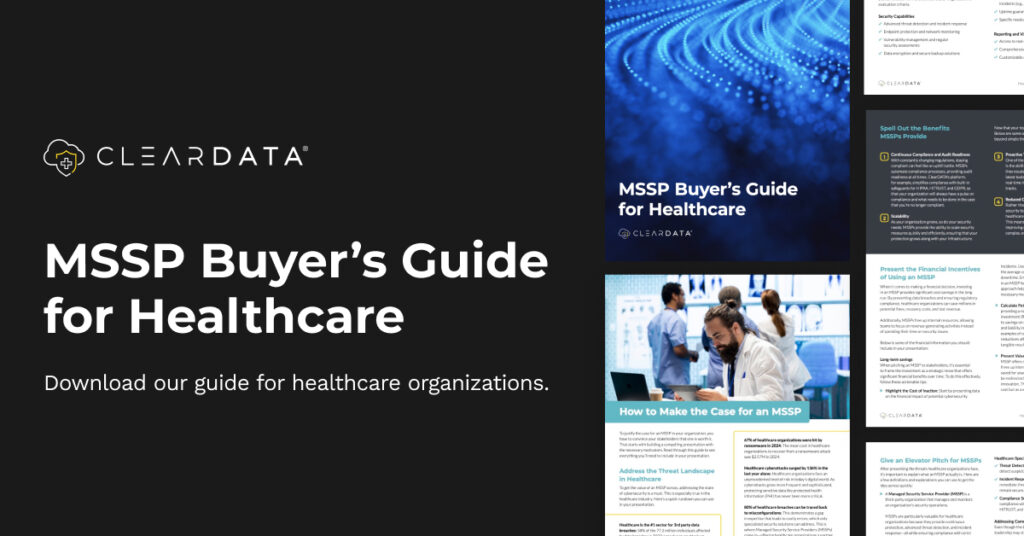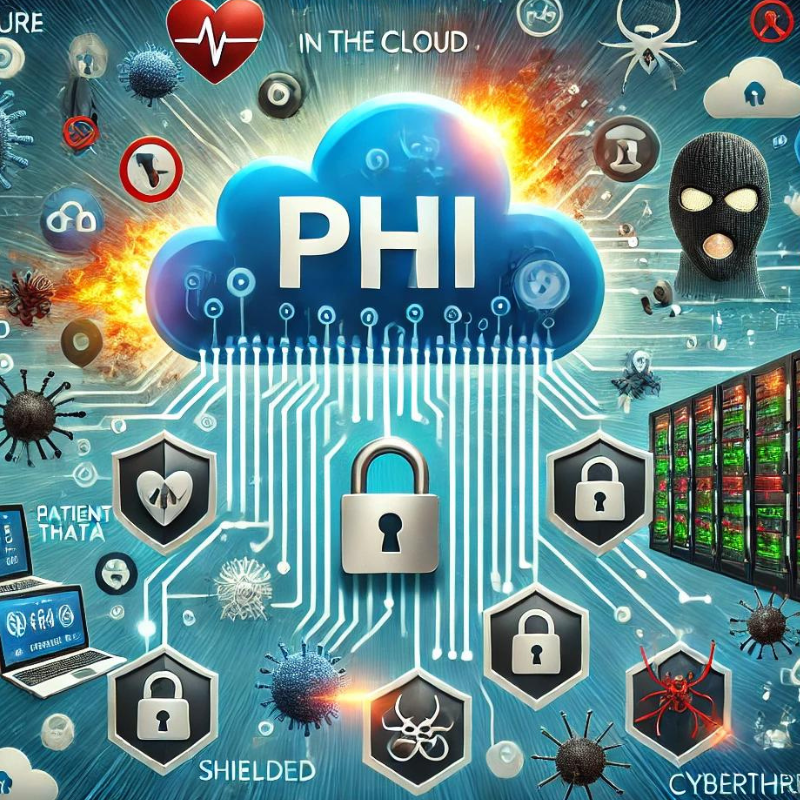A Complete Guide to Healthcare Security & Compliance in the Cloud
Healthcare compliance and security have become some of the most challenging yet critical priorities for organizations within the healthcare industry. With the widespread adoption of cloud computing, protecting sensitive data, such as Protected Health Information (PHI), while meeting stringent regulatory requirements, is no longer optional—it’s a necessity.
Healthcare compliance and security isn’t just about avoiding penalties or reducing compliance debt; it’s about safeguarding patient privacy, guaranteeing the ethical handling of data, building trust, and protecting patient safety.
But how do you maintain compliance and security in cloud environments where healthcare industry regulations are stringent and new risks appear constantly?
Below, we’ve outlined the eight steps your healthcare organization must take to understand healthcare compliance and security challenges in the cloud and adopt best practices for maintaining continuous compliance and protection.
Healthcare Compliance
Understand Key Healthcare Industry Regulations
Healthcare compliance revolves around adherence to several healthcare industry regulations including HIPAA, HITECH, HITRUST, and GDPR. Here’s a brief overview of what these regulations aim to achieve in the context of healthcare compliance:
- HIPAA (Health Insurance Portability and Accountability Act): HIPAA ensures the confidentiality, integrity, and availability of electronic Protected Health Information (ePHI). This includes implementing administrative, physical, and technical safeguards to protect patient data in the cloud.
- HITECH (Health Information Technology for Economic and Clinical Health Act): HITECH strengthens HIPAA by promoting the adoption of electronic health records (EHRs) and providing incentives for healthcare organizations to secure these records effectively.
- HITRUST (Health Information Trust Alliance Common Security Framework): HITRUST provides a prescriptive framework that incorporates regulatory and risk-based security controls, helping organizations achieve scalable compliance.
- GDPR (General Data Protection Regulation): For healthcare organizations handling data of EU citizens, GDPR mandates strict rules for data handling and transparency, even in global cloud environments.
- GxP (Good Practices): GxP is a set of FDA guidelines designed to ensure the safety, quality, and efficacy of bio/pharmaceutical products. It encompasses practices like Good Clinical Practice (GCP), Good Laboratory Practice (GLP), and Good Manufacturing Practice (GMP).
Examples of Compliance in Healthcare
Here are some examples of compliance in healthcare that can help organizations meet the healthcare industry regulations listed above:
- HIPAA-Compliant EHR Systems
Hospitals and clinics implement EHR systems with built-in encryption, access controls, and audit logs so patient data remains secure and accessible only to authorized personnel.
- Employee Training Programs
Regularly scheduled training sessions educate staff on privacy rules, data handling best practices, and how to identify potential phishing attempts.
- Business Associate Agreements (BAAs)
Healthcare organizations sign BAAs with third-party vendors who handle patient data, such as cloud storage providers or billing companies. - Data Breach Notification Protocols
In compliance with the HITECH Act, organizations have defined processes for notifying patients, the government, and other stakeholders in the event of a data breach. For example, a healthcare practice immediately informs affected individuals and files reports with the HHS department.
Implementing healthcare compliance protocols aligned with the above healthcare industry regulations not only ensures legal adherence but also fortifies organizations against the severe consequences of non-compliance, such as data breaches and financial penalties. For a deeper look at HIPAA compliance, explore our blog that explains everything in the HIPAA Security Rule.
Leverage AI for Compliance and Security Efficiency
Artificial Intelligence (AI) and Machine Learning (ML) are transforming healthcare compliance strategies. There are many benefits to AI in healthcare when implemented correctly, including:
- Automated Compliance Monitoring: AI detects anomalies and non-compliance with greater speed and precision than manual efforts.
- Mitigated Risks: Predictive analytics can identify potential vulnerabilities or threats and recommend timely interventions.
- Improved Operational Efficiency: By automating repetitive tasks, AI allows IT teams to focus on strategic initiatives.
Protect PHI in the Cloud With a Healthcare Compliance Plan
Securing PHI in the cloud is a top priority for healthcare organizations. To safeguard PHI in the cloud, implement a healthcare compliance plan that includes strategies for:
Data Encryption
Encryption is a fundamental layer of protection for PHI stored in the cloud. By encrypting data both at rest and during transmission, data will remain unreadable even if intercepted or accessed without authorization. Here are our top tips for data encryption:
- Use end-to-end encryption protocols for secure communication between systems, including interoperability strategies.
- Regularly update encryption keys to mitigate potential vulnerabilities.
- Employ a secure socket layer (SSL) or transport layer security (TLS) for data transmission.
Access Controls
Role-based access control (RBAC) allows only authorized personnel to access or manage PHI, minimizing the risk of untrustworthy third-party vendor risk management, insider threats, and data breaches. Here’s how you can implement access controls for healthcare compliance:
- Implement multifactor authentication (MFA) to add an extra layer of security for user access.
- Regularly review access permissions so they align with current roles and responsibilities.
- Use identity and access management (IAM) solutions to streamline and secure user access control.
Audit Trails
Maintaining a comprehensive log of all access and changes to PHI helps organizations detect and respond to unauthorized activities. These audit trails are also critical for demonstrating healthcare compliance during audits. Here’s what you should do to effectively manage audit trails:
- Automate logging processes to capture all access attempts and data modifications.
- Regularly review logs for anomalies or unauthorized access attempts.
- Utilize log analysis tools that provide alerts for unusual or suspicious activity.
Automated PHI Discovery and Protection
Manually locating and protecting PHI in vast, unstructured datasets can be challenging. Automated tools simplify this process by identifying, tagging, and securing PHI across systems. Here’s how you can do it:
- Deploy data discovery tools that use machine learning to locate PHI in structured and unstructured formats.
- Use automated compliance monitoring systems to flag any non-compliant handling of PHI.
- Implement cloud-native tools that integrate directly into your environment to provide real-time PHI protection.
Secure Cloud Configurations
Misconfigured cloud environments are a leading cause of data breaches. Aligning cloud configurations with best practices is critical for protecting PHI. Here’s what you should do:
- Conduct regular security assessments to identify misconfigurations.
- Use cloud security posture management (CSPM) tools to automate compliance checks and enforce configuration policies.
- Enable virtual private networks (VPNs) and virtual private clouds (VPCs) to isolate sensitive data.
Incident Response Plans for Cloud-Based PHI
Despite the best defenses, breaches can occur. A robust incident response plan enables swift and effective action to minimize damage. Here are some tips:
- Develop a detailed incident response plan tailored to cloud environments.
- Conduct regular drills to test the plan and refine processes.
- Include data recovery and forensic investigation protocols in the response plan.
Employee Training and Awareness
The human factor often remains the weakest link in data protection. Training staff to recognize phishing attempts, social engineering tactics, and proper PHI handling protocols is essential.
- Offer regular training sessions tailored to the latest cyber threats and compliance requirements.
- Provide clear guidelines on how employees should handle PHI securely in cloud systems.
- Foster a culture of accountability where all team members prioritize data security.
Healthcare Cloud Cybersecurity
Conduct Cybersecurity Risk Assessments
To safeguard healthcare data in the cloud, healthcare organizations must conduct Security Risk Assessments (SRA). These assessments allow healthcare organizations to:
- Identify Vulnerabilities: Pinpoint cybersecurity weaknesses, such as insecure configurations or gaps in data protection protocols, that could expose sensitive information.
- Evaluate Risk: Assess the likelihood and impact of potential cybersecurity threats to prioritize remediation efforts.
- Validate Compliance: Determine whether your organization meets regulatory requirements as your cloud environment evolves.
Here’s what a typical assessment includes:
- PHI Inventory Creation and Review: The assessment begins with creating and reviewing an inventory of PHI. This step identifies where electronic and other sensitive data resides. The inventory is stored in a secure portal, allowing easy access for audits and future risk assessments.
- Evaluation of Current HIPAA Security Practices: An in-depth analysis of your organization’s current HIPAA compliance measures, including safeguards, vulnerabilities, and potential threats, is conducted. This evaluation determines whether your practices align with healthcare industry regulations.
- Examination of HIPAA-Required Safeguards: The assessment thoroughly reviews the three HIPAA-required safeguards under 45 CFR 164.308 (a)(1):
-
-
- Administrative Safeguards: Policies and procedures for managing ePHI security.
- Physical Safeguards: Protections for systems and facilities from unauthorized physical access.
- Technical Safeguards: Technologies and methods to secure ePHI, such as secure access controls and encryption.
- Administrative Safeguards: Policies and procedures for managing ePHI security.
-
- Reviewing Access Controls and Data Encryption Standards: The process evaluates access control mechanisms so that only authorized personnel can access sensitive information. Data encryption standards are also reviewed to confirm that PHI is appropriately encrypted in transit and at rest.
- Active Testing Through Penetration Testing and Vulnerability Scans: The cloud environment is tested for weaknesses using penetration testing and vulnerability scans. These proactive measures identify exploitable vulnerabilities, allowing for immediate remediation and enhanced security.
- Security Policies and Procedures Evaluation: A review of existing security policies and procedures shows if they are effective, comprehensive, and up-to-date with industry best practices. Any gaps are identified and addressed.
- Risk Remediation Planning: After identifying risks, a remediation plan is developed, categorizing risks as high, medium, or low. The plan includes actionable recommendations tailored to your organization’s size and complexity. A SaaS-based tool is often used to assign roles and track progress, assuring accountability and timely resolution.
By reviewing access controls, identifying vulnerabilities, maintaining an inventory of IT assets, and prioritizing risks based on impact, SRAs help organizations stay compliant, mitigate threats, and protect patient data. Regular assessments, conducted annually or after significant changes, are essential to maintaining robust cybersecurity and safeguarding patient trust.
Need help conducting an SRA? Here are the several questions you need to know to inform your annual assessment.
Enlist a Managed Service Provider
Managing security and compliance in the cloud can be resource-intensive, leaving many healthcare organizations struggling to keep up. This is where Managed Service Providers (MSPs) play a pivotal role. By partnering with an MSP, healthcare organizations can access industry expertise, cloud infrastructure management, and compliance support.
Leading MSSPs like ClearDATA specialize in healthcare cloud compliance, offering tailored solutions that streamline operations and keep organizations aligned with stringent regulatory requirements. Services include:
- Continuous monitoring of cloud infrastructure for security.
- Automated compliance reporting to simplify auditing processes.
- Proactive management of cloud environments to prevent misconfigurations and breaches.
- Remediations of cloud vulnerabilities performed on your behalf.
If you feel as though your healthcare organization doesn’t have the internal capacity to handle the onslaught of increasingly sophisticated cyber threats, read through our MSSP Buyer’s Guide for Healthcare.
In this guide, you’ll learn to:
- Visualize the newest cyber threats to your healthcare cloud.
- Identify key MSSP benefits, including reducing operational burdens, supporting compliance, and enhancing security cost-effectively.
- Choose an MSSP that aligns with your organization’s needs and objectives.
- Evaluate whether your new MSSP partner is effectively protecting your cloud.
Mitigate Threats with Managed Detection and Response (MDR)
Managed Detection and Response (MDR) enhances cloud security by providing real-time threat detection and mitigation.
MDR solutions typically include:
- 24/7 Monitoring: Around-the-clock observation of your cloud environment to identify potential risks.
- Threat Intelligence: Using advanced analytics to detect sophisticated cyberattacks that traditional defenses might miss.
- Incident Response: Rapid response teams that minimize the impact of detected threats to maintain compliance.
How ClearDATA’s MDR Benefits Users
ClearDATA’s MDR solutions are tailored specifically to the healthcare industry, combining healthcare compliance practices with unparalleled security capabilities.
- Ongoing Defense Against Modern Threats
ClearDATA’s advanced threat detection and vulnerability protection shields your cloud environment from sophisticated cyber threats, including malware, ransomware, and zero-day attacks. - Faster Threat Neutralization
Respond to and recover from cyber threats up to five times faster than managing them in-house. Unlike many MSSPs that only provide recommendations, ClearDATA takes prioritized action on your behalf while keeping you informed every step of the way. - Enhanced Visibility with Real-Time Insights
ClearDATA’s CyberHealth™ Platform offers real-time alerts and an interactive dashboard, providing complete transparency into incident status, threat intelligence, and key performance indicators. - Rapid Risk Remediation
Specialized remediation services close exposure gaps and minimize risks, keeping your cloud environment fortified against future attacks. ClearDATA’s experts act swiftly to secure your systems and strengthen your attack surface. - Tailored SecOps Solutions for Healthcare
With solutions crafted specifically for healthcare organizations, ClearDATA’s SecOps addresses the industry’s unique challenges, from compliance to patient data protection. - Access to Exclusive Healthcare-Specific Threat Intelligence
ClearDATA leverages a healthcare-focused threat intelligence network, continuously enhancing your security posture. - Expertise in Healthcare Compliance
With decades of cybersecurity experience, ClearDATA provides tailored solutions that meet the intricate demands of healthcare compliance, aligning organizations with HIPAA, HITRUST, and other regulatory requirements. - Cost-Effective Cybersecurity
ClearDATA delivers affordable, enterprise-grade cybersecurity without requiring healthcare organizations to invest in expensive in-house teams or infrastructure. This allows you to enhance security while staying within budget.
Utilize the AWS Well-Architected Framework
For organizations operating on AWS, the AWS Well-Architected Framework offers invaluable guidance for maintaining secure cloud infrastructure. This framework provides a structured approach for:
- Optimizing Workloads: Improve cloud configurations to reduce costs while maintaining the highest level of security
- Enhancing Security: Implement security best practices to ensure the protection of sensitive health data.
- Ensuring Resilience: Develop disaster recovery plans to minimize downtime and data loss.
Maintain Cybersecurity Best Practices
Adopting robust cybersecurity practices is non-negotiable for the healthcare cloud. Best practices include:
- Enforcing Multi-Factor Authentication (MFA): Strengthen account security by requiring multiple verification steps.
- Regular Software Updates: Keep all systems patched to reduce vulnerabilities.
- Employee Training: Continuously educate staff on identifying and mitigating cybersecurity threats.
- Implementing Endpoint Detection and Response (EDR): Monitor and respond to suspicious activities on devices connected to your network.
- Conducting Regular Vulnerability Assessments: Proactively identify and address security gaps to prevent potential breaches.
- Establishing a Robust Incident Response Plan: Make sure your team is prepared to act swiftly in the event of a cyberattack.
- Limiting Access Privileges: Apply the principle of least privilege to minimize the potential impact of compromised accounts.
For a detailed guide on implementing cybersecurity practices, refer to our Essential Cybersecurity Tips in Healthcare guide.
Future-Proof Your Organization’s Healthcare Compliance and Security
Continuous healthcare compliance and security in the cloud is not a one-time effort but an evolving process that requires cyber resiliency. To future-proof and strengthen your healthcare organization:
- Conduct regular Security Readiness Assessments.
- Leverage AI and MDR to stay ahead of modern threats.
- Partner with reputable MSSPs to offload compliance complexities.
Ultimately, achieving compliance, security, and healthcare cloud resiliency requires dedication, expertise, and the right partners. Take the first step today by scheduling a consultation with the healthcare compliance experts at ClearDATA.
FAQ
Who is responsible for ensuring a healthcare organization’s compliance?
In a healthcare organization, the Chief Compliance Officer (CCO) typically oversees the organization’s overall compliance strategy, while IT and security teams manage the technical aspects
Why is compliance important in healthcare?
Compliance in healthcare is essential for protecting patient safety, privacy, and trust. Adhering to healthcare industry regulations like HIPAA ensures that sensitive data, such as Protected Health Information (PHI), is kept secure and confidential, reducing the risk of breaches and unauthorized access.
What is HIPAA compliance in healthcare?
HIPAA compliance in healthcare refers to adhering to the regulations set forth by the Health Insurance Portability and Accountability Act (HIPAA). HIPAA compliance requires healthcare organizations to implement administrative, physical, and technical safeguards to protect PHI, both in digital and physical forms. This includes controlling access to sensitive data, ensuring data encryption, conducting regular risk assessments, and maintaining secure communication channels.
What is healthcare compliance?
Healthcare compliance refers to the process by which healthcare organizations adhere to laws, regulations, and standards that govern the industry. These include federal and state laws, such as HIPAA, as well as industry standards like HITRUST or ISO 27001. By adhering to these requirements, healthcare organizations can safeguard patient trust, avoid legal and financial repercussions, and foster a culture of accountability and safety.
Secure Your Healthcare Cloud



